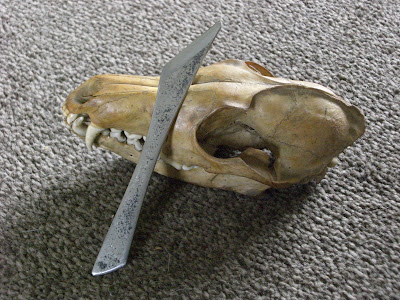One of the things I like about bushcraft style camping is the use of tarps as shelters. A tarp at it's simplest is a sheet of fabric, which can be made of either synthetic or natural fibre, with webbing loops and/or eyelets around the edge. Tarps are used mainly for shelter but they are a truely multi-purpose item, they can be used for wrapping kit, carrying, water collection, foraging, coracle making, etc. I like using tarps as shelters because of the flexibility they give me, and also because of their light weight and low bulk.
The classic way to pitch a tarp is between two trees, with the ridge more or less horizontal and the four corners stretched out to give a good pitch to the roof. I probably use this set up more than any other as it has some great advantages.
I can get into or out of my shelter from any direction so I don't churn up any one bit of ground, I can see out in every direction so I can watch the world around me, I can hang a line under the ridge to hang all my kit from, plenty of fresh air gets through it, it provides lots of shade, I can sit up, and I can cook under my shelter. The downside to this set up is that it does very little in the way of keeping the wind out, so if it's windy and raining you have to be careful not to get wet, for that reason I nearly always use a bivi bag with this set up.
 |
| "Classic" tarp set up at a BCUK meet at Spitewinter |
One way to make the "classic" set up more weatherproof is to lower the ridgeline slightly and to peg one side of the tarp down to the ground. This set up is a lot less drafty than the "classic" set up and works better when there's a combination of wind and rain, and this is just the shelter that I would choose for those conditions. The open front still allows plenty of options for access and lets me have a view out of one side at least.
 |
| Open fronted set up on my birthday 2011 |
A natural progression from the open fronted set up is the low profile set up, with this shelter the ridgeline is even lower with both sides of the tarp touching, or almost touching, the ground. This set up is better still at keeping the weather off and does a good job of retaining your body heat through the night.
The disadvantages of this shelter are the same as with the open-fronted set up, only more so. The view is more or less non existent, access is severely restricted, there's not much space inside, etc. I only really use this type of shelter for quick overnight camps where I'll be striking camp first thing in the morning so only really need a shelter to keep me and my kit dry whilst I sleep.
It's probably the quickest and easiest of set ups that I use regularly, the shelter below was set up at about 2a.m. on a really frosty winters morning with a belly full of beer and lots of "helpful" advice from friends. Even facing such difficulties it was still only a five minute job to set up.
 |
| Low Profile set up on my birthday 2012 |
An even more weatherproof set up is the one below, this time the ridge of the tarp goes straight down to the ground at the back of the shelter (no ridgeline's used for this one), and the back corners are stretched out tight so that one side of the tarp is flat to the floor. With the back of the shelter into the wind, and with the tarp pegged tightly to the ground this set up will keep off all but the very worse of the British weather.
As you can see from the pictures below I can use this set up quite easily without trees as long as I've got at least one pole, here I'm using my walking staff. the combination of tree-free set up and good weather protection makes this my set up of choice for a night on the moors.
The downsides to this set up are; not a great deal of space to sit up, it can get hot and stuffy inside, condensation invariably forms on the underside of the tarp, you can only get in and out one way, there's not much of a view, and it needs lots of pegs (15 in total but it'll work with 9 on good ground). The feature of this set up that makes it superior to most others is the fact that in the wettest and windiest of weather I can still have warm and weatherproof shelter in a couple of minutes, and that could possibly be a life-saver one day.
 |
| Front yard tarpology (the neighbours have got used to me!) |
 |
| An idea of how steeply the roof slopes, it's only about 12" from the ground in the middle |
These are the four set ups that I use most often, there are lots more ways to set up a tarp, and sometimes I use some of those too, but these four cover 95% of situations for me. I'll be posting quite a bit more about tarps I reckon, it's a big topic.
Bye for now,
Stuart


















.jpg)
